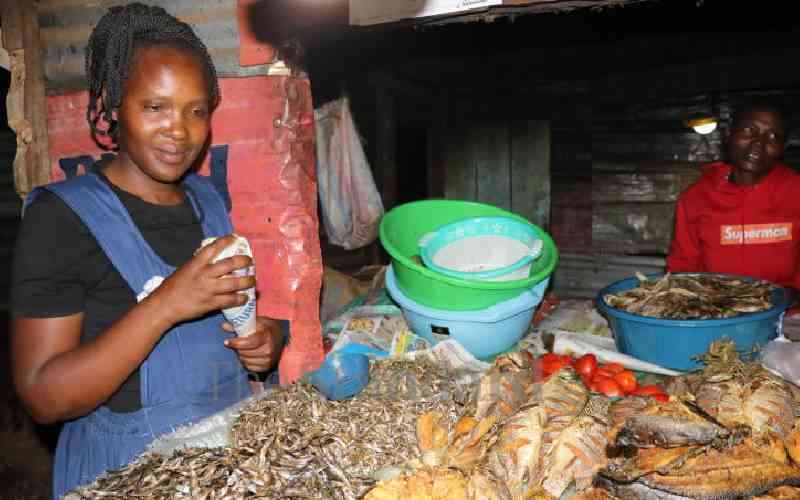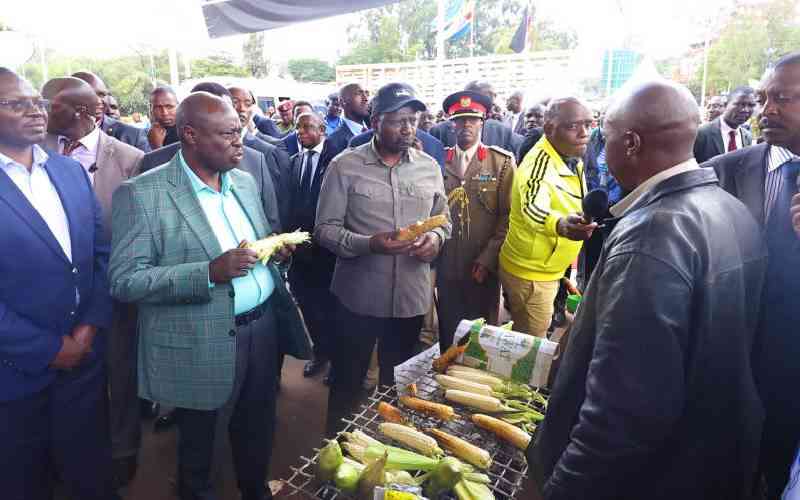
Since 2012, Kenya’s expenditure has been like that of a household that buys sufurias, gas cooker, micro-wave and refrigerator but forgets the most essential thing: food.
In five years, the quantity and quality of food Kenyans have consumed has nose-dived, threatening the access and affordability of the commodity by the most vulnerable citizens.
This is even as the country’s economy has grown from 4.6 per cent in 2012 to 5.8 per cent in 2016, aided by massive investment in roads, ports, rails, machinery, and computers or even fabricated metals used to produce sufuria.
However, the supply of calories, proteins and fats which are critical for the well being and productivity of a country’s population, has been erratic and barely improved since 2011, according to the Economic Survey 2017.
While part of this can be blamed on the unpredictable weather, experts opine that there has been a general neglect of the agricultural sector in general, and food security in particular by successive governments.
The Economic Survey 2017 shows that daily per capita supply of calories, unit of energy contained in food and used by the human body to maintain daily healthy life, has gone down dramatically from 2,447,000 kilocalories in 2012 to 2,156,000 kilocalories in 2016.
This points to a lackluster investment in the production of cereals such as maize, wheat, rice, millet and sorghum which are critical sources of calories.
Per Capita Daily Caloric Supply (amount of food available for consumption, measured in kilocalories per capita per day) from cereals decreased by 3.4 per cent from 920,000 kilocalories in 2015 to 890,000 kilocalories in 2016.
It was the same with Per Capita Caloric Supply from animal products which decreased by 13.1 per cent from 313,000 kilocalories in 2015 to 272,000 kilocalories in 2016.
Daily supply of protein and fats also went down. Per capita daily supply of proteins declined from 74 grams in 2012 to 64 grams in 2016, while that of fats decreased from 47 grams to 44 grams. “Low investment in agriculture has been the main cause of low productivity. This has resulted in low production as well as in low calorie intake,” said Dr Dennis Otieno, a research fellow at Tegemeo Institute, a research think-tank affiliated to Egerton University.
According to the United Nation’s Food and Agricultural Organisation, in its 2015 Statistical Pocketbook: World Food and Agriculture ranks Kenya among the bottom 20 countries in the world in terms of dietary energy supply (DES). DES is the food available for human consumption, and is expressed in expressed in kilocalories per person per day.
The East African economic powerhouse also sits among the bottom 20 countries in terms of undernourishment- or a level of food intake insufficient to meet dietary energy requirements, an indictment of Kenya’s food security.
In terms of undernourishment, Kenya, the ninth largest economy in Africa, ranked ahead of only 13 countries: Central Africa Republic, Côte d’Ivoire, Burkina Faso, Cameroun, Rwanda, Malawi, Chad, Zimbabwe, Angola, Zambia, Madagascar, Uganda and Mozambique.
XN Iraki, a lecturer at the University of Nairobi, says that incentives for farmers to engage in the production of food crops are now as attractive as those in cash crops. “Profits seems to matter more than food security. That is why non-food crops take more investment than food crops. Private sector rarely focus on food crops, it seems the government has forgotten its job,” explained Iraki.
Fertiliser subsidy
Stay informed. Subscribe to our newsletter
“Yet, if there was less government in food crops, there might be more food produced,” he adds. Government involvement through subsidies seems to have created a distortion in the market rather than help it, according to the World Bank. The fertiliser subsidy programme that targets the majority smallholder farmers has, instead, worked against them, a situation that has left many to shoulder expensive inputs such as seeds and storage.
Government has put in place measures to shift Kenyans from rain-fed agriculture by launching massive irrigation projects such as Galana Kulalu, but so far, nothing significant has come out of these investments.
The country has still been ravaged by a debilitating drought that has seen prices of basic food commodities skyrocket. The price of a two-kilogram maize flour, a vital ingredient in the preparation of Kenya’s staple food ugali, is currently retailing at Sh160 in most supermarkets; milk has also gone up from around Sh50 last month to Sh60. Most retail stores are rationing sugar, with a two-kilogram of the commodity going at Sh415 as of Saturday.
Production of cash-crops such as tea, coffee and flowers, on the other hand, do not seem to have suffered the same fate as food crops that are produced mainly for domestic consumption.
Tea, coffee, and horticulture are Kenya’s keyf foreign exchange earners.
The Economic Survey found “notable growths in production of coffee and tea” even as agricultural sector was “dampened by considerable declines in production of food crops.”
Production of tea and coffee increased by 18.5 and 10.8 per cent, in 2016, respectively. “On the other hand, production of cereals and leguminous crops went down significantly in 2016. Specifically, production of maize declined from 42.5 million bags in 2015 to 37.1 million bags in 2016 while that of beans dropped from 8.5 million bags in 2015 to 8.1 million bags in 2016.
Production of potatoes and drought resistant crops such as sorghum and millet recorded significant declines,” read the survey in part. This even as the country has pumped billions in expensive capital goods aimed at developing the country, in what one legislator has wittingly described as the Government’s obsession with the new standard gauge railway at the expense of the old strategic grain reserve.
Iraki regrets that food producers have been left on their own , with small farms, old methods of production and old cultures of subdivision of land. “Farming is yet to get its ‘Uber moment’ which is likely to be private sector driven,” noted Iraki.
In the Maputo Declaration of 2003, signatory countries, including Kenya, agreed to, among other things, allocate at least 10 per cent of their budgets towards agricultural and rural development. “Currently, Kenya allocated about five per cent of its budget to agriculture.
This is way below the expected 10 per cent as per the Malabo declaration of which Kenya is a signatory,” said Dr Otieno. “Unlike the high value crops which have high capital investment, investment in staples has been low. This has affected implementation of National and County level activities,” added Odhiambo, noting that extension services are wanting in the production of staples and most of the staple farming is done for home consumption.
 The Standard Group Plc is a
multi-media organization with investments in media platforms spanning newspaper
print operations, television, radio broadcasting, digital and online services. The
Standard Group is recognized as a leading multi-media house in Kenya with a key
influence in matters of national and international interest.
The Standard Group Plc is a
multi-media organization with investments in media platforms spanning newspaper
print operations, television, radio broadcasting, digital and online services. The
Standard Group is recognized as a leading multi-media house in Kenya with a key
influence in matters of national and international interest.
 The Standard Group Plc is a
multi-media organization with investments in media platforms spanning newspaper
print operations, television, radio broadcasting, digital and online services. The
Standard Group is recognized as a leading multi-media house in Kenya with a key
influence in matters of national and international interest.
The Standard Group Plc is a
multi-media organization with investments in media platforms spanning newspaper
print operations, television, radio broadcasting, digital and online services. The
Standard Group is recognized as a leading multi-media house in Kenya with a key
influence in matters of national and international interest.










